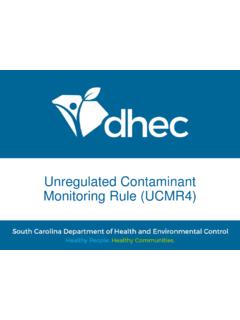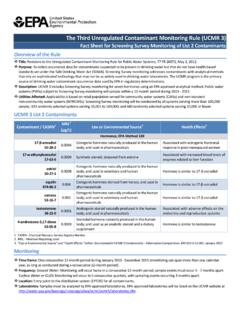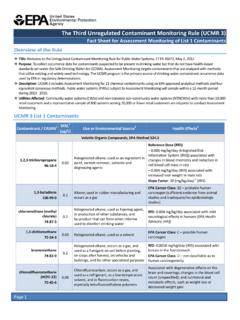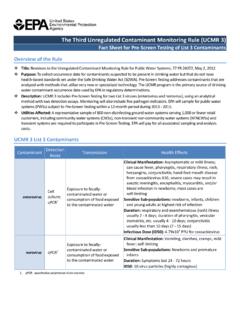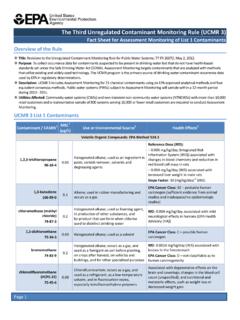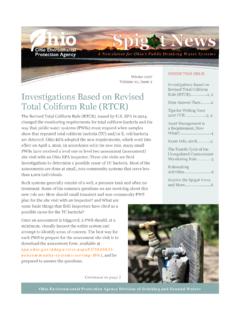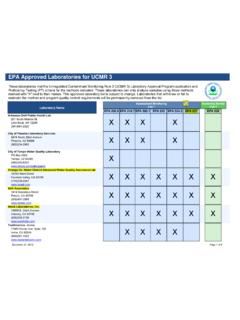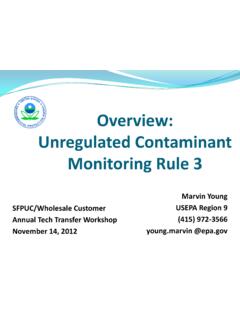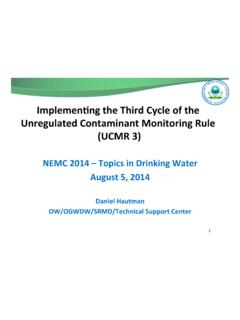Transcription of The Fourth Unregulated Contaminant Monitoring Rule …
1 4/10/20171 The Fourth Unregulated Contaminant Monitoring Rule (UCMR 4)Public Meeting and WebinarApril 12, 201710:00 ETUSEPAO ffice of Ground Water and Drinking Water WelcomeGregory Carroll, USEPA4/10 Environmental Protection AgencyApril 2017 3 General Meeting Information Purpose Describe the requirements of EPA s UCMR 4 and provide a forum for public questions and discussion Schedule Break for lunch at noon ET Resume at 1:30 ET 10 minute break at approximately 2:30 ET Public questions and discussion at the end of the Environmental Protection AgencyApril 2017 4 Participating by Webinar Listen only mode Click on + next to Questions in the control panel (Figure 1) to submit questions/comments Type a question in the box.
2 Click send (Figure 2) Submit questions as soon as possible Questions will be answered at the end of the presentationsFigure 1 Figure 24/10 Environmental Protection AgencyApril 2017 5 Agenda10:00 10:10 Welcome, Introduction, Agenda (10 minutes)10:10 10:30 Overviewofthe UCMR Program(20 minutes)10:30 10:50 Overview of UCMR4(20 minutes)10:50 11:40 UCMR 4 Sample Collection & Frequency(50 minutes)11:40 12:00 UCMR 4 Laboratory Approval Process and MRLs (20minutes)Q&AandDiscussion if presentationsend early (untillunch)12:00 1:30 Lunch Break(90 minutes)1:30 2:30 SDWARS and Reporting Requirements(60 minutes)2:30 2:40 RiskCommunication(10 minutes)2:40 2:50 Closing Remarks(5 minutes)2:50 3:00 Break(10 minutes)3:00 4:00 Q&AandDiscussion (60 minutes)Overview of the UCMR ProgramGregory Carroll, USEPA4/10 Environmental Protection AgencyApril 2017 7 Overview Regulatory background for UCMR SDWA authority Relationships to.
3 Contaminant Candidate List (CCL) Regulatory Determination Six Year Review UCMR Objectives Approach Environmental Protection AgencyApril 2017 8 SDWA Passed in 1974, SDWA authorized EPA to set enforceable health standards for contaminants in drinking water National Primary Drinking Water Regulations (NPDWRs) 1986 SDWA amendments were the basis for the original UCMR State drinking water programs managed the original UCM program PWSs serving > 500 people were required to monitor 1996 SDWA amendments changed the process of developing and reviewing NPDWRs CCL UCMR Regulatory Determination Six Year Review4/10 Environmental Protection AgencyApril 2017 9 General Flow of SDWA Regulatory ProcessesIncreased specificity and confidence in the type of supporting data used ( , health, occurrence, treatment) is needed at each stage.
4 Regulatory DeterminationRegulatory DeterminationCCLCCLRuleRuleReviewReviewU CMRUCMRD raft CCLF inal CCLF inal UCMRD raft UCMRUCMR Monitoring ResultsFinal Rule(NPDWR)Proposed Rule(NPDWR)Six Year Review of Existing NPDWRsPreliminary Regulatory DeterminationsFinal Regulatory Determinations24months18monthsNo further action if decision is to not regulateMay develop health advisory!!!Public Review and Comment!! Environmental Protection AgencyApril 2017 10 CCL List of priority Unregulated contaminants Published every five years Known or anticipated to occur in public water systems (PWSs) May require regulation under SDWA The Final CCL 4 was published November 17, 2016 and included 97 chemicals or chemical groups and 12 microbes4/10 Environmental Protection AgencyApril 2017 11 General Flow of SDWA Regulatory ProcessesIncreased specificity and confidence in the type of supporting data used ( , health, occurrence, treatment) is needed at each stage.
5 Regulatory DeterminationRegulatory DeterminationCCLCCLRuleRuleReviewReviewU CMRUCMRD raft CCLF inal CCLF inal UCMRD raft UCMRUCMR Monitoring ResultsFinal Rule(NPDWR)Proposed Rule(NPDWR)Six Year Review of Existing NPDWRsPreliminary Regulatory DeterminationsFinal Regulatory Determinations24months18monthsNo further action if decision is to not regulateMay develop health advisory!!!Public Review and Comment!! Environmental Protection AgencyApril 2017 12 UCMR SDWA section 1445(a)(2), established requirements for the UCMR Program: Issue list of no more than 30 Unregulated contaminants, once every 5 years Require PWSs serving population >10,000 people as well as a nationally representative sample of PWSs serving 10,000 people to monitor Store analytical results in the National Contaminant Occurrence Database for Drinking Water (NCOD) EPA funds shipping/analytical costs for small PWSs EPA manages program in partnership with states4/10 Environmental Protection AgencyApril 2017 13 UCMR History UCMR 1 (2001 2005, 26 contaminants) UCMR 2 (2007 2011, 25 contaminants) UCMR 3 (2012 2016, 30 contaminants) UCMR 4 (2017 2021, 30 contaminants)
6 Published in the FR on December 20, 2016 PWSs monitor 2018 2020 Each new UCMR cycle is established via a revision to the rule for the ongoing/preceding Environmental Protection AgencyApril 2017 14 Objective of UCMR Program Collect nationally representative occurrence data for Unregulated contaminants that may require regulation under the SDWA Consider data collected as part of future EPA decisions on actions to protect public health Provide data to States, local governments and to the public for their use in decisions regarding public health protection. National occurrence data publically available: data Unregulated Contaminant Monitoring rule 4/10 Environmental Protection AgencyApril 2017 15 UCMR Approach UCMR approach relies on using one or more of 3 Monitoring tiers Assessment Monitoring (List 1) Screening Survey (List 2) Pre Screen Testing (List 3) Based on.
7 Availability and complexity of analytical methods Laboratory capacity Sampling frequency Relevant universe of PWSs Other considerations ( , cost/burden) Environmental Protection AgencyApril 2017 16 Typical UCMR System ApplicabilitySystem TypeSystemsServing> 10,000 Systems Serving 10,000 Assessment Monitoring (List 1 Contaminants)CWS & NTNCWS All systems800 randomly selected systemsScreening Survey (List 2 Contaminants)CWS & NTNCWSAll systems serving more than 100,000, and320 randomly selected systems serving 10,001 to 100,000480 randomly selected systemsPre Screen Testing (List 3 Contaminants)May be conducted by a limited number of PWSsNOTE: UCMR 4 only includes Assessment Monitoring for List 1 Contaminants4/10 Environmental Protection AgencyApril 2017 17 General Process for Developing UCMR Early public stakeholder meetings Discuss method development for emerging contaminants Discuss anticipated elements of the proposal Agency development of the proposal Includes a workgroup of multi state and multi office representatives, and tribal consultation Proposal publication in the Federal Register (FR)
8 Provides a 60 day public comment period Post proposal public stakeholder meeting Final rule publication in the FR Post final rule public stakeholder meeting Review final rule and prepare for Environmental Protection AgencyApril 2017 18 EPA Implementation Roles Review, track and determine PWS applicability and monitor progress Coordinate Laboratory Approval Program Provide technical support to Regions, states, PWSs and laboratories Coordinate outreach Assist and support Regional compliance efforts4/10 Environmental Protection AgencyApril 2017 19 EPA Implementation Roles Small PWS support: Fund small system testing including:kits, sample analysis and shipping Manage sample kit distribution Maintain lab and implementation contracts to support UCMR Conduct data review Large and small PWS support: Manage SDWARS reporting system and support users Posts data to Environmental Protection AgencyApril 2017 20 States Role in the UCMR Program Participation by states, tribes and territories (herein after referred to as States ) is voluntary State roles are documented via Partnership Agreements (PAs) States help EPA implement the UCMR program.
9 Help to ensure high data quality PA activities can include any/all of the following: Review and revise state Monitoring plans (SMPs) Provide inventory for small and large systems Review and approve proposed ground water representative Monitoring plans (GWRMPs) Provide compliance assistance Notify and instruct systems Collect samples Other4/10 Environmental Protection AgencyApril 2017 21 General Flow of SDWA Regulatory ProcessesIncreased specificity and confidence in the type of supporting data used ( , health, occurrence, treatment) is needed at each stage. Regulatory DeterminationRegulatory DeterminationCCLCCLRuleRuleReviewReviewU CMRUCMRD raft CCLF inal CCLF inal UCMRD raft UCMRUCMR Monitoring ResultsFinal Rule(NPDWR)Proposed Rule(NPDWR)Six Year Review of Existing NPDWRsPreliminary Regulatory DeterminationsFinal Regulatory Determinations24months18monthsNo further action if decision is to not regulateMay develop health advisory!
10 !!Public Review and Comment!! Environmental Protection AgencyApril 2017 22 Regulatory Determinations Every five years, the Administrator shall, after notice of the preliminary determination and opportunity for public comment, for not fewer than five contaminants included on the CCL, make determinations on whether or not to regulate such contaminants. SDWA requires EPA to publish a maximum Contaminant level goal (MCLG) and promulgate an NPDWR for a Contaminant if the Administrator determines that:*SDWA Section 1412(b)(1)1. The Contaminant may have an adverse effect on the health of persons;2. The Contaminant is known to occur or there is substantial likelihoodthat the Contaminant will occur in public water systems with a frequency and at levels of public health concern; and3.
